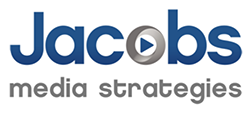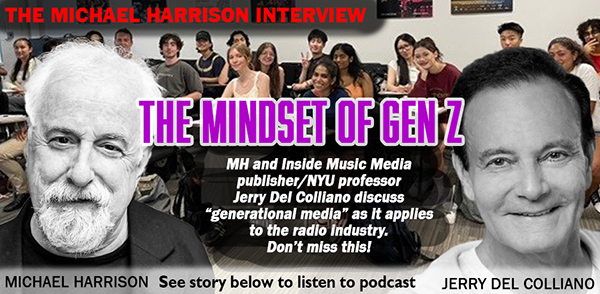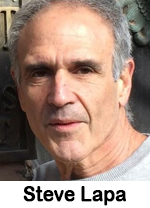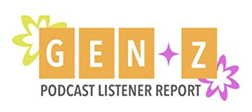By Bill Bartholomew
Talk Host/Podcaster/Journalist/Musician
 Folks in the Gen Z and millennial demographics are heavily engaged in political issues, care about news in their communities and the world, and are constantly bombarded with content. So why are they less likely to tune into and interact with news/talk radio than older demographics?
Folks in the Gen Z and millennial demographics are heavily engaged in political issues, care about news in their communities and the world, and are constantly bombarded with content. So why are they less likely to tune into and interact with news/talk radio than older demographics?
Talk radio has historically skewed older, and from an ad portfolio standpoint, is often targeted at the coveted 35-54 and 55+ demographics. However, in a world where social media influencers and podcasters supply information to millions of young consumers, news/talk radio should be able to effectively compete for the ears of younger generations in a comparable, if not expanded way.
For all of the anecdotal and hard evidence that terrestrial radio may be trending in a downward direction, the format continues to have a vast reach. It is convenient to engage with it in automobiles, and occasionally in home or office settings. Yet, while younger generations listen to radio, news/talk is not the format that they turn to by and large.
Unlike many digital-first content producers, radio retains a unique quality: authority. By virtue of editorial standards, FCC regulation and brand – things that social media and podcasts often lack – radio has the unique ability to deliver credible, vetted, nuanced and universally trustworthy content that can instantaneously adapt to meet the needs of the moment. This is true in everything from natural disasters to rapidly evolving breaking news stories, providing a channel for immediate, reactionary insight and analysis.
There are several steps that news/talk radio should pursue in earnest to adapt to the current climate of content consumption, particularly by younger listeners, that can reach, and most importantly, retain broader, younger, more diverse and more engaged audiences.
- Introduce younger people into the conversation.
Too often, Gen Z and millennials are skewered by older hosts, mocked for their perceived naivety, unchecked optimism and me-first approach. While some of these qualities can be accurate, that approach reflects a disconnect between older generations and the experience of younger ones. Millennials and Gen Z have grown up in a post-9/11 world replete with “endless wars”, the fallout from the 2008 financial crisis, runaway student debt, a massive housing crisis, the mental health stressors of social media, Covid19’s impact on traditional youth experiences, climate change, a deeply bifurcated political environment and a constantly evolving quest for social justice. Through these experiences, younger generations offer an important perspective that should be assigned the same news value as experts from older generations.
Are you discussing shifts towards electric vehicles? Bring on someone from Gen Z to share their perspective on why steps towards carbon neutrality are important to them. Engaging a conversation on the president’s approval rating? Perhaps younger conservative and leftist voices should be included in the conversation. Discussing immigration? How about the perspective of a younger member of a Latino organization?
By giving younger generations and more diverse guests a platform, stations can simultaneously expand their content and reach. With consistency, the station’s brand will become more familiar to younger potential listeners who may be inclined to tune in to hear someone who shares their identity and perspective on – here’s that word again – a platform of authority. Let the guest do the work of establishing the credibility and importance of your station or talk show to younger audiences by posting about their appearance on social media, sharing audio clips and mentioning to their peers. It will build familiarity and trust among those generations, who in turn, will begin to tune in on a more regular basis.
Stations should also consider bringing more younger, competent voices into on-air roles, whether that be through reporting, segments, fill-in hosts, weekend shows or full-time hosts.
- Meet the audience where they are: their phones.
As mentioned above, the convenience of simply turning on AM/FM radio is highly appealing in automobiles, though as Apple Carplay continues to adapt and evolve, digital-first content is likely to become as simple and convenient in the near future.
Talk radio needs to make consuming their product on smartphones as simple and direct as turning on a traditional radio. This means no clunky websites, no lengthy pre-roll spots, a reliable stream connection and a “one touch” means of turning on and off the station. This should also mean expanding talk shows to high-quality video livestreams, following in the footsteps of the top YouTube and Twitch performers; developing unique content for TikTok and Instagram; building podcasts that are focused on specific issues, and; providing interaction via text and chat.
Radio has the ability to be the ultimate livestreamer, social media influencer and podcaster, but rarely harnesses these platforms in a meaningful way.
It is not enough to simply strive to “expand a digital presence”; stations and shows must engage in the hard work of building platform-specific content with their brands.
- Music, cultural references and themes for the modern age.
A few weeks ago on a seemingly benign episode of the TV show FOX NFL Sunday, panelists Jimmy Johnson and Terry Bradshaw offered an example of the type of cultural adaptation that sophisticated writers and producers provide their brands. While describing a fight between two football players, Mr. Johnson said something to the effect of “when it comes to these two, what’s that Taylor Swift song?”, and then in synch with Mr. Bradshaw, “bad blood!”. It is highly unlikely that these two 70+ men listen to Taylor Swift’s music with any regularity or would simultaneously pull the “Bad Blood” reference. Yet, with excellent preparation that played into the greater cultural moment as well as the specific, current Taylor Swift/NFL overlap, in a six-second span, FOX NFL Sunday was able to give the illusion that their panelists are contemporary, hip and plugged into “what is going on”. Is your station or show plugged into what’s going on? Do you use contemporary music for bumps? Are your images – including headshots and social content – modern, interesting and engaging or are they more akin to a miscellaneous real estate agent? You are a performer in an entertainment business that, while certainly paying homage to the past and lineage of the industry, must be contemporary in aural and visual presentation. This goes for everything from wardrobe on video and in photo to fonts on graphic design.
How often do you or your producer read Pitchfork to learn about new music that is breaking this week? How often do you or your producer read Variety to understand major trends that are happening in the broader entertainment industry? What live events are you broadcasting from, covering and building partnerships with? You should strive to be cutting edge.
- We need a friend now more than ever.
This is something that goes for all audiences, but particularly for younger ones. It’s OK, in fact, great to be yourself, present yourself from your generation and retain the authoritative stance that has built your brand. Take a look at the success that sports talker Mike Francesa enjoyed by leaning into his persona – and in turn – developing legions of younger listeners that fell in love with his dad-like delivery and frequent meltdowns.
Few things are as uncomfortable to see as a 40+ person dressing or acting like a teenager. Younger listeners want that senior, experienced, trusted friend to entertain them, inform them, and at times, tell them that everything is going to be OK. You can help make sense of the world for younger audiences, something that is absolutely essential in the modern era.
Through attracting younger listeners by including them in the conversation, effectively delivering content on smartphones, presenting a cutting-edge entertainment product and continuing to serve as a trusted friend, news/talk radio can greatly expand its reach, relevance and revenue.
To that point, some younger listeners who discover a radio station or show via any of the above entry points will likely work backwards to the traditional AM/FM dial. Like the resurgence of vinyl records, AM radio in particular has the opportunity to become a hip delivery format for discerning younger listeners.
The big question is: are radio companies, stations and hosts prepared to do the hard work of reimaging their product?
Share this with your network
 respondents are most likely to say they use it at least weekly. There’s a strong feeling the government will need to step in to provide legal guard rails for AI use. Three in four (75%) are looking for some form of regulation. In fact, more than a third (36%) believe AI will need to be highly regulated. That perception may be fueled by the upcoming elections this November. About half (51%) say they’re very concerned about how AI might affect this fall’s political races. Members of the Greatest Generation and Boomers are most fearful of how the technology might influence upcoming elections. When it comes to three applications for radio – AI hosts, AI-voiced commercials, and AI-voiced station IDs – the biggest pushback predictably is directed at the idea of radio using cloned voices to take the place of live talent. Three in four (75%) raise the red flag over this AI application. Concern lessens when it comes to AI voice technology being used to read commercials. Still, nearly four in ten (39%) say they have big issues with radio stations they listen to using AI in ads. Respondents are most open to the idea of AI voices being utilized on station identification. Overall, about one-third (34%) have no problem, but a similar sized group (30%) expresses major concerns with this use case for AI. Jacobs Media general manager Paul Jacobs remarks, “It is still early days for AI in radio, but broadcasters need to respect the many concerns voiced by core fans of the medium. Up to now, many decisions have been made in a vacuum. Now the audience has a voice. We’ll be tracking their perceptions in Techsurveys in the coming years as the technology matures. The format level data for AI should provide welcome feedback for radio managers trying to get a handle on AI.”
respondents are most likely to say they use it at least weekly. There’s a strong feeling the government will need to step in to provide legal guard rails for AI use. Three in four (75%) are looking for some form of regulation. In fact, more than a third (36%) believe AI will need to be highly regulated. That perception may be fueled by the upcoming elections this November. About half (51%) say they’re very concerned about how AI might affect this fall’s political races. Members of the Greatest Generation and Boomers are most fearful of how the technology might influence upcoming elections. When it comes to three applications for radio – AI hosts, AI-voiced commercials, and AI-voiced station IDs – the biggest pushback predictably is directed at the idea of radio using cloned voices to take the place of live talent. Three in four (75%) raise the red flag over this AI application. Concern lessens when it comes to AI voice technology being used to read commercials. Still, nearly four in ten (39%) say they have big issues with radio stations they listen to using AI in ads. Respondents are most open to the idea of AI voices being utilized on station identification. Overall, about one-third (34%) have no problem, but a similar sized group (30%) expresses major concerns with this use case for AI. Jacobs Media general manager Paul Jacobs remarks, “It is still early days for AI in radio, but broadcasters need to respect the many concerns voiced by core fans of the medium. Up to now, many decisions have been made in a vacuum. Now the audience has a voice. We’ll be tracking their perceptions in Techsurveys in the coming years as the technology matures. The format level data for AI should provide welcome feedback for radio managers trying to get a handle on AI.”


 Folks in the Gen Z and millennial demographics are heavily
Folks in the Gen Z and millennial demographics are heavily 
 Last week, with little time left on the clock, Disney and Charter Communications made a deal so that Charter customers could continue to watch Disney programming. Phew! Just in time for 15 million Charter cable customers to have access to that 53-year-old American institution called “Monday Night Football.”
Last week, with little time left on the clock, Disney and Charter Communications made a deal so that Charter customers could continue to watch Disney programming. Phew! Just in time for 15 million Charter cable customers to have access to that 53-year-old American institution called “Monday Night Football.” monthly podcast listeners started listening as a child, 57% started listening as a teenager and 25% started listening as an adult. This means 73% of Gen Z monthly podcast listeners began listening before the age of 18; 3) Those who began listening earlier in life, listen longer: Gen Z monthly podcast listeners who started listening as a child consume 10.6 hours of podcasts per week; those who started as a teenager consume 7.5 hours per week, and those who started as an adult consume 6.6 hours of podcasts per week. The average for all Gen Z monthly podcast listeners is 7.7 hours per week; and 4) Gen Z act as a result of podcast ads: 82% of Gen Z monthly podcast listeners have taken any action as a result of hearing a podcast advertisement; 70% have either purchased or wanted to purchase the product or service they heard advertised, 61% have visited a company or product website, 44% have used a promo code or discount code mentioned in the podcast, and 42% have recommended a product to a friend or family member.
monthly podcast listeners started listening as a child, 57% started listening as a teenager and 25% started listening as an adult. This means 73% of Gen Z monthly podcast listeners began listening before the age of 18; 3) Those who began listening earlier in life, listen longer: Gen Z monthly podcast listeners who started listening as a child consume 10.6 hours of podcasts per week; those who started as a teenager consume 7.5 hours per week, and those who started as an adult consume 6.6 hours of podcasts per week. The average for all Gen Z monthly podcast listeners is 7.7 hours per week; and 4) Gen Z act as a result of podcast ads: 82% of Gen Z monthly podcast listeners have taken any action as a result of hearing a podcast advertisement; 70% have either purchased or wanted to purchase the product or service they heard advertised, 61% have visited a company or product website, 44% have used a promo code or discount code mentioned in the podcast, and 42% have recommended a product to a friend or family member.  American Life. Other radio related podcasts that placed in the top 50 include “The Ben Shapiro Show” (#8), “The Ramsey Show” (#17), and “The Dan Bongino Show” (#25). The latest ranker from Edison Podcast Metrics shows the Top 50 Podcasts based on weekly audience reach and reflects two significant updates to the service that were implemented last year. The sample has been expanded to include weekly podcast listeners age 13-17. This measurement allows podcast producers and networks to understand the teen segment of the Gen Z podcast listeners. The ranker also includes increased sample size, which allows for more recency in reporting and robust cuts of data. The latest ranker includes measurement from the previous two quarters with a total sample size of 10,797 weekly podcast listeners age 13+.
American Life. Other radio related podcasts that placed in the top 50 include “The Ben Shapiro Show” (#8), “The Ramsey Show” (#17), and “The Dan Bongino Show” (#25). The latest ranker from Edison Podcast Metrics shows the Top 50 Podcasts based on weekly audience reach and reflects two significant updates to the service that were implemented last year. The sample has been expanded to include weekly podcast listeners age 13-17. This measurement allows podcast producers and networks to understand the teen segment of the Gen Z podcast listeners. The ranker also includes increased sample size, which allows for more recency in reporting and robust cuts of data. The latest ranker includes measurement from the previous two quarters with a total sample size of 10,797 weekly podcast listeners age 13+.  #6, Cumulus Podcast Network’s “The Dan Bongino Show” at #19, and The Ramsey Network’s “The Ramsey Show” at #22. This latest ranker shows the Top 50 Podcasts based on weekly audience reach and reflects two significant updates to the service. Edison says the sample has been expanded to include weekly podcast listeners age 13-17. This measurement allows podcast producers and networks to understand the teen segment of the Gen Z podcast listeners. The Q4 ranker includes increased sample size implemented last year, which allows for more recency in reporting and robust cuts of data. The latest ranker includes measurement from the previous two quarters with a total sample size of 10,597 weekly podcast listeners age 13+.
#6, Cumulus Podcast Network’s “The Dan Bongino Show” at #19, and The Ramsey Network’s “The Ramsey Show” at #22. This latest ranker shows the Top 50 Podcasts based on weekly audience reach and reflects two significant updates to the service. Edison says the sample has been expanded to include weekly podcast listeners age 13-17. This measurement allows podcast producers and networks to understand the teen segment of the Gen Z podcast listeners. The Q4 ranker includes increased sample size implemented last year, which allows for more recency in reporting and robust cuts of data. The latest ranker includes measurement from the previous two quarters with a total sample size of 10,597 weekly podcast listeners age 13+. podcast listening behaviors. “The Gen Z Podcast Listening Report” from SXM Media and Edison Research “provides an in-depth look at the podcast habits and motivations of the elusive and much-desired Gen Z listener.” Edison vice president Megan Lazovick says, “Everything we do at Edison Research works to drive the audio space forward with the highest quality data. We believe these two studies will help advertisers understand the opportunities for audio to reach these two important generations and of course help the media companies who can deliver these audiences.”
podcast listening behaviors. “The Gen Z Podcast Listening Report” from SXM Media and Edison Research “provides an in-depth look at the podcast habits and motivations of the elusive and much-desired Gen Z listener.” Edison vice president Megan Lazovick says, “Everything we do at Edison Research works to drive the audio space forward with the highest quality data. We believe these two studies will help advertisers understand the opportunities for audio to reach these two important generations and of course help the media companies who can deliver these audiences.”